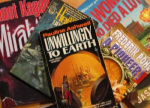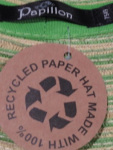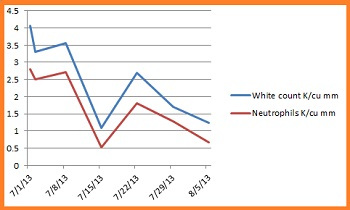 If you are going to get chemo or a bone marrow transplant, you will probably be spending a lot of time with low physical and social energy. You may also be in the market for some distraction from the whole “will this cure me?” and “holy mackerel, my stomach is queasy” trains of thought. You could watch tv, but, having been through it earlier this year, I recommend spending the bulk of your distraction time (times when you do not have energy for prayer, email, or conversation) reading. It’s more calming.
If you are going to get chemo or a bone marrow transplant, you will probably be spending a lot of time with low physical and social energy. You may also be in the market for some distraction from the whole “will this cure me?” and “holy mackerel, my stomach is queasy” trains of thought. You could watch tv, but, having been through it earlier this year, I recommend spending the bulk of your distraction time (times when you do not have energy for prayer, email, or conversation) reading. It’s more calming.
Here’s where, as someone with an Ivy League Ph.D. in literature, I have a golden opportunity to urge people to read Middlemarch, except that in my opinion that is the exact wrong thing to read during chemotherapy. (Well, technically, the exact wrong thing to read is Thomas Hardy’s Jude the Obscure, which also happens to be the wrong thing to read in almost *every* context–that book really puts the “ick” in “Victorian.” My deepest apologies to the one class I forced to read it. I don’t know what I was thinking.)
My point is, right now you’re looking for something light and entertaining, possibly something that you read and enjoyed some years back. One friend suggested the Father Brown mysteries, but as I am more a sci fi fan, here is my favorite list. Hope it inspires a list for you!
-The Thursday Next series by Jasper Fforde, about a woman who comes to work at Jurisfiction, the policing agency within fiction. My favorite scene is when she and Miss Havisham have to take a turn running the rage management group in Wuthering Heights. You could skip this series if a near-endless series of silly jokes does not compensate for you for a lack of consistent characterization, but I find the jokes and brisk if ridiculous plots to be just the ticket. Forget about suspending your disbelief–just expel it altogether. You’ll be glad you did.
-Urusla le Guin’s The Lathe of Heaven and, well, pretty much all the rest of her sci fi (except for Vietnam-protest The Word for World is Forest). These novels might not technically qualify as light reading, but I love le Guin’s prose too much to care.
-The Heinlein juvie novels. I agree with few of Heinlein’s politics, many of the ’50s-era assumptions are laughable, and he went a little nuts with the semicolons sometimes, but darn he could tell a story. The editors at Scribner’s kept his juvies free from the pointless sex and shapeless plots that mar many of his later novels.
-The Chronicles of Narnia. Could skip The Horse and his Boy and The Last Battle if the racism pisses you off too much.
-The Harry Potter series (possibly skipping the last book or two).
-John Scalzi’s Fuzzy Nation. Want a probing, nuanced tale of how first contact with an alien species could go wrong? Then read Mary Doria Russell’s The Sparrow and Children of God. On the other hand, if you want something lightweight and fun (yet not as dated as the 1962 H. Beam Piper novel it’s based on), read Fuzzy Nation.
–Unwillingly to Earth by Pauline Ashwell [aka Paul Ashwell, aka Paul Ash], which has a bit of a Podkayne of Mars feel to it, except I like it better than Podkayne because the wide-eyed girl character was not written by a dirty old man, and nobody says that women who have careers are failing their children. Ending’s on the dated side, though (parts of the novel were written as far back as 1958). Might be hard to get hold of.
-Connie Willis’ To Say Nothing of the Dog is a middleweight time travel romp set mainly in the Victorian period and the screwball-comedy genre. Hyperbole-phobes should avoid it. (Note: Willis’ other time-travel novels are *not* romps, especially Doomsday Book).
-Connie Willis’ Bellweather, an almost too lightweight romp about historian/scientists, with a side order of anecdotes about silly fads past and present.
-Janet Kagan’s Mirabile is a collection of short stories set on a planet settled by Earthlings. The folks who originally sent out the colonizers had the bright idea of burying extra species’ genetic code in the junk DNA of Earth plants and animals sent along, so every once in a while random animals and/or hybrids pop up and need to be dealt with. Put aside the horror that you’d actually have about introducing Earth animals into a functioning alien ecosystem to begin with, or the question of how a mostly agricultural society can manufacture all this advanced gene-reading equipment, and just enjoy the antics and love story. Not in print, but hey, everything’s bound to be an e-book soon, right?
Frederick Pohl’s O Pioneer! This slim novel is about a hacker turned mayor on a planet colonized by humans and five other species. It’s pleasantly lightweight, milking a lot of humor from bad translation software (though the genealogy of this is obviously in “foreigners speak funny” tropes, I can live with it transferred to software). Written in 1996, the novel evokes a little eye-rolling with its emphasis that look–the couple next doors are lesbians! Not that there’s anything wrong with that! Whatever.
-Neal Stephenson’s Anathem. This one might not be to your taste–it’s a 900-page yarn set on a semi-Earthlike planet where there’s a millennia-old tradition of institutions that function rather like monasteries, except in the service of academic knowledge rather than theism. There are a number of dips into epistemology and such, and the ending is a bit hard to follow if you are distracted by medical anxiety, but by and large Stephenson manages to heap tall tale on tall tale enough to make what I consider a very satisfying read. There are also great flashes of humor, as when he explains that the unit of false information on the planet’s internet-analogue is the “bogon.”
John Barnes’ A Million Open Doors. Far-future story in which planetary cultures have been set up by people obsessed with art or religion, and a protagonist from the troubadour planet winds up on the Protestant Work Ethic planet, where the capital city is Utilitopia and Adam Smith is revered as a martyr. There are duels and romance and the plot goes by so briskly I’d read it three times and was halfway through teaching it before I realized it’s also the most fun defense of Keynesian economics that has ever been, or ever will be, written.
WARNING: The next book in this series, set during the protagonist’s midlife crisis, is interesting but depressing, and some of Barnes’ other novels outside this series have pretty gratuitous (though not approving) scenes of rape. (John Barnes has noted in an interview that his Duke of Uranium series, an attempt to imitate the Heinlein juvies, didn’t go over well. Hint, Mr. Barnes: maybe it’s not that the crisis-every-25,000-word pattern is dated; maybe it’s the *icky unconsensual sex* you put in.)All blog content copyright © 2012-2014 E. Palmberg. Guaranteed 100% brave and freaking noble.



